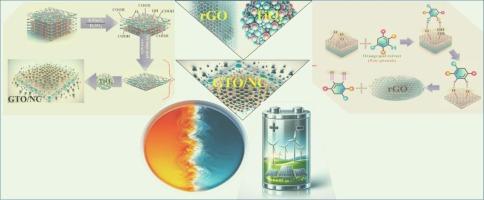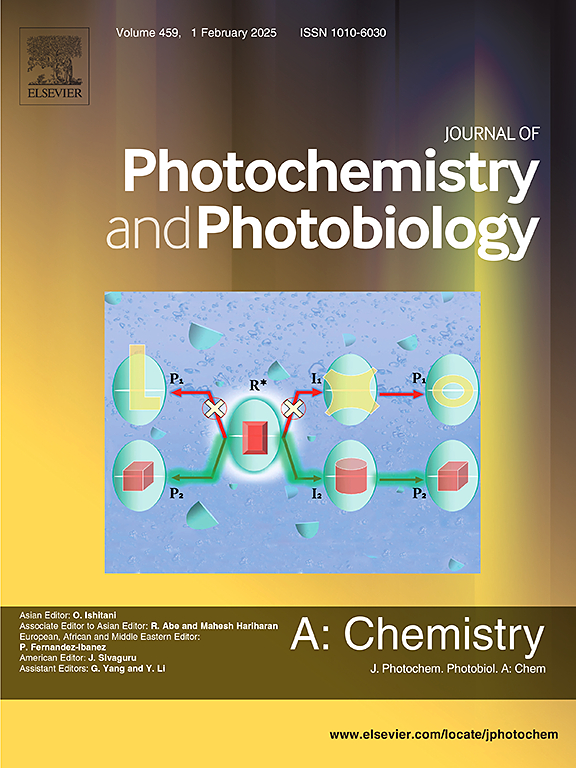Eco-friendly synthesis and applications of graphene-titanium dioxide nanocomposites for pollutant degradation and energy storage
IF 4.1
3区 化学
Q2 CHEMISTRY, PHYSICAL
Journal of Photochemistry and Photobiology A-chemistry
Pub Date : 2024-10-17
DOI:10.1016/j.jphotochem.2024.116096
引用次数: 0
Abstract
An innovative, eco-friendly method has been developed to synthesize reduced graphene oxide (rGO) sheets using orange peel extract. Following this, TiO2 nanoparticles are anchored to the rGO sheets through a hydrothermal process, resulting in an rGO/TiO2 nanocomposite (GTO/NC). This study utilized standard characterization techniques to confirm the formation of GTO/NC-1 and GTO/NC-2. Comparative analysis demonstrated that orange peel extract exhibits reducing capabilities compared to other natural reducers. The resulting GTO/NC-1 and GTO/NC-2, specifically GTO/NC-2, enhanced catalytic performance in degrading methyl orange a prevalent organic pollutant in various industrial applications. This nanocomposite achieved a turnover frequency of 0.003 mg MO/mg catalyst/min and displayed remarkable durability, enduring 3.0 cycles with robust first-order rate constants of 0.0193 min−1. Additionally, the electrochemical properties of GTO/NC-1 and GTO/NC-2 as electrode materials were assessed, revealing a specific capacitance of 320.0 Fg−1 at a current density of 1.0 Ag−1 and maintaining about 86.8 % of its initial capacitance after various charge–discharge cycles. These properties highlight the potential of GTO/NC-1 and GTO/NC-2 as both efficient catalysts for environmental remediation and durable materials for energy storage applications, offering substantial benefits for sustainable technology solutions.

用于污染物降解和能量存储的石墨烯-二氧化钛纳米复合材料的生态友好合成与应用
利用橙皮提取物合成还原型氧化石墨烯(rGO)薄片是一种创新的环保方法。随后,通过水热工艺将二氧化钛纳米颗粒锚定到 rGO 片材上,形成 rGO/TiO2 纳米复合材料(GTO/NC)。本研究利用标准表征技术确认了 GTO/NC-1 和 GTO/NC-2 的形成。对比分析表明,与其他天然还原剂相比,橘皮提取物具有还原能力。生成的 GTO/NC-1 和 GTO/NC-2,特别是 GTO/NC-2,在降解甲基橙(一种在各种工业应用中普遍存在的有机污染物)方面提高了催化性能。这种纳米复合材料的翻转频率达到 0.003 毫克 MO/毫克催化剂/分钟,并显示出卓越的耐久性,可持续 3.0 个循环,一阶速率常数为 0.0193 分钟-1。此外,还对 GTO/NC-1 和 GTO/NC-2 作为电极材料的电化学特性进行了评估,结果表明,在电流密度为 1.0 Ag-1 时,其比电容为 320.0 Fg-1,在各种充放电循环后,其比电容保持在初始电容的 86.8%左右。这些特性彰显了 GTO/NC-1 和 GTO/NC-2 作为环境修复的高效催化剂和储能应用的耐用材料的潜力,为可持续技术解决方案提供了巨大优势。
本文章由计算机程序翻译,如有差异,请以英文原文为准。
求助全文
约1分钟内获得全文
求助全文
来源期刊
CiteScore
7.90
自引率
7.00%
发文量
580
审稿时长
48 days
期刊介绍:
JPPA publishes the results of fundamental studies on all aspects of chemical phenomena induced by interactions between light and molecules/matter of all kinds.
All systems capable of being described at the molecular or integrated multimolecular level are appropriate for the journal. This includes all molecular chemical species as well as biomolecular, supramolecular, polymer and other macromolecular systems, as well as solid state photochemistry. In addition, the journal publishes studies of semiconductor and other photoactive organic and inorganic materials, photocatalysis (organic, inorganic, supramolecular and superconductor).
The scope includes condensed and gas phase photochemistry, as well as synchrotron radiation chemistry. A broad range of processes and techniques in photochemistry are covered such as light induced energy, electron and proton transfer; nonlinear photochemical behavior; mechanistic investigation of photochemical reactions and identification of the products of photochemical reactions; quantum yield determinations and measurements of rate constants for primary and secondary photochemical processes; steady-state and time-resolved emission, ultrafast spectroscopic methods, single molecule spectroscopy, time resolved X-ray diffraction, luminescence microscopy, and scattering spectroscopy applied to photochemistry. Papers in emerging and applied areas such as luminescent sensors, electroluminescence, solar energy conversion, atmospheric photochemistry, environmental remediation, and related photocatalytic chemistry are also welcome.

 求助内容:
求助内容: 应助结果提醒方式:
应助结果提醒方式:


